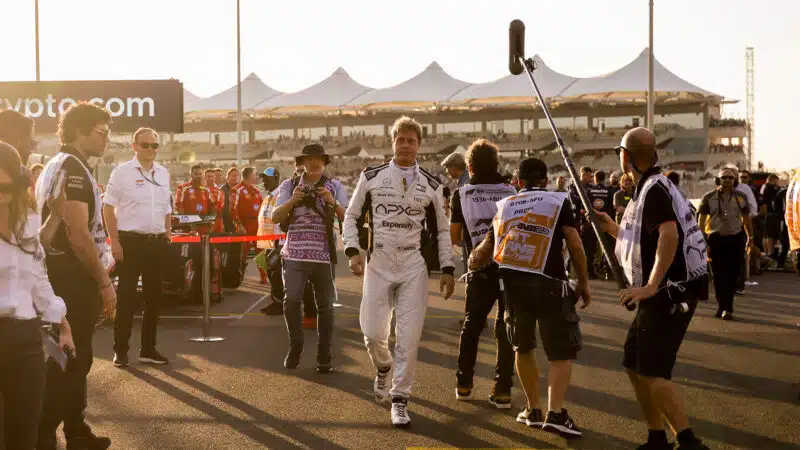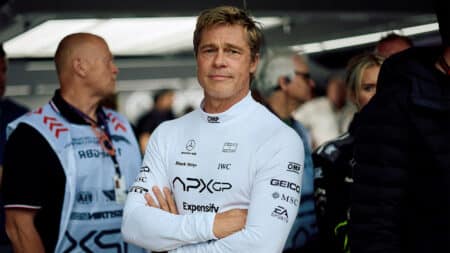The latest three-minute teaser for F1 gave a more detailed look at the lengths to which producers have gone to make the racing blockbuster as authentic as possible.
According to F1 director Joseph Kosinski — whose most recent work includes the award-winning Tom Cruise picture Top Gun: Maverick — the production of F1 has been innovative in many respects, with a concentration on keeping the film “grounded”.
“You can talk about speed but we wanted to make audiences feel it,” he said. “The camera technology we developed for Maverick was groundbreaking. But on F1 we’ve pushed it even further.
“Getting footage for this story has been awesome, the energy of the crowd, all the F1 drivers, the cars, everything is going to help this film get that kind of grounded quality that we’re looking for. It’s always better to overachieve than underachieve. And boy did we overachieve.”
Below, we detail everything we know so far about how F1 has been made, including specifics on the cameras, the budget, the cars and the locations.
What was the budget for F1?
F1 initially had a rumoured budget of $300m — placing it firmly among some of the most expensive films ever made. To many this made sense, given the world championship’s world-renowned high-roller reputation as well as the estimated cost of making and filming a functional (yet fictional) grand prix team.
But, in an interview with Deadline, producer Jerry Bruckheimer clarified that the production could reclaim some of the outlay and that — like real F1 teams — sponsors were footing some of the bill in return for advertising space on the car.
“It’s completely, unfortunately, tens of millions of dollars out of whack in the wrong direction, and in the right direction for us,” he said. “What people don’t realise is, first of all, we’re shooting in rebate [locations], England has a big rebate, lots of Europe has rebates and so does Abu Dhabi. It all lowers the budget.
“Plus, we’ve raised more money for our car [through sponsorship] than some Formula 1 teams. You take that all into consideration and it really drops that number quite a bit lower than what people would think.”
Apple Original Films, the studio behind F1, is yet to disclose an actual budget.
The cameras
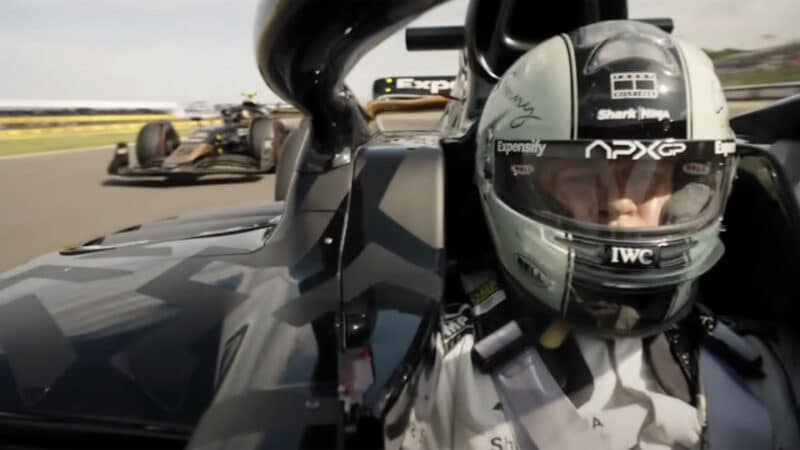
The cameras used in F1 were produced by Sony and Mercedes
F1
Throughout F1’s behind-the-scenes video, fans are shown the array of cameras that have been used to capture the intense on-board shots which feature heavily in the film’s two teaser trailers.
Oscar-winning cinematographer Claudio Miranda worked closely with Sony and Mercedes to develop a custom camera that has the power to capture the high-speed nature of the world championship while still being small enough to fit in a car’s cockpit alongside a driver.
The system — which was also used in Top Gun: Maverick — effectively separates the body of the camera from the sensor and dramatically reduces its footprint. This allowed Miranda to mount a total of seven cameras around the cockpit — giving viewers an eye-of the-driver feel as well as a sensation of speed.
“We had to have bespoke cameras for this that are very small and light so that they don’t impede the performance of the car too much and that’s key because you don’t want to have a race car and then put 200 pounds of gear on it,” Kosinski told Deadline. “It’s the next generation from what we did on Top Gun.”
“Everything is much smaller and the big innovation that is that we’re now able to control the movement of the cameras on the cars. We’re not locked into these kinds of fixed positions we had on Top Gun. Now we have real-time control of panning and focusing them while shooting through a very extensive RF (radio frequency) network that we’ve built around the tracks.”
The ability to pan the cameras wirelessly has proved particularly effective for shooting overtaking scenes, as Kosinski could first show a shot of Pitt in the cockpit as he was pursued by another driver before panning to the other car as he was passed.
The cars
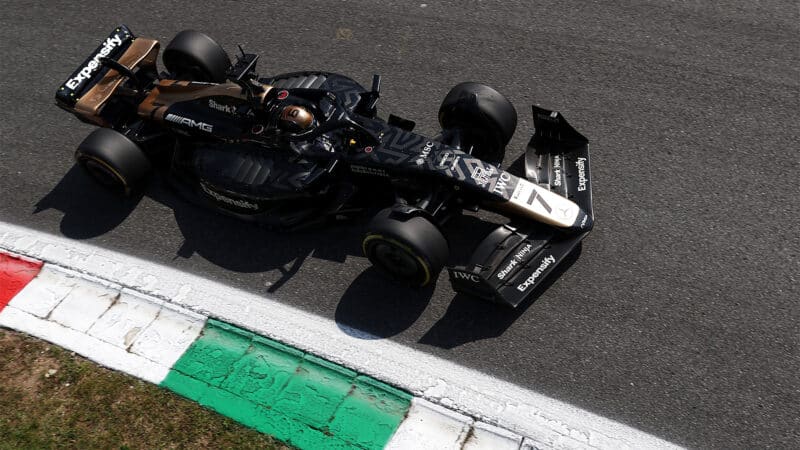
APXGP have been spotted at several circuits so far — including Monza (as pictured above)
Getty Images
The Apex GP cars used in F1 were produced by Mercedes, which modified Formula 2 cars into F1 look-a-likes.
The car has an F2 chassis and engine but has been equipped with custom body parts that make it appear longer and wider — therefore blending it with the rest of the F1 grid.
Producers worked closely with the Mercedes design team as well as its aerodynamics department to maintain authenticity and ensure that, above all, they remained quick.
“They all complain that racing movies aren’t fast enough because usually when they build these cars, they’re movie cars,” said Kosinski. “You know, they look right, but they aren’t real race cars.”
“But these cars are built specifically for this movie. They also have 15 camera mounts built into them, including the recorders and the batteries and the transmitters. They’re made for shooting movies, but they are fundamentally race cars.
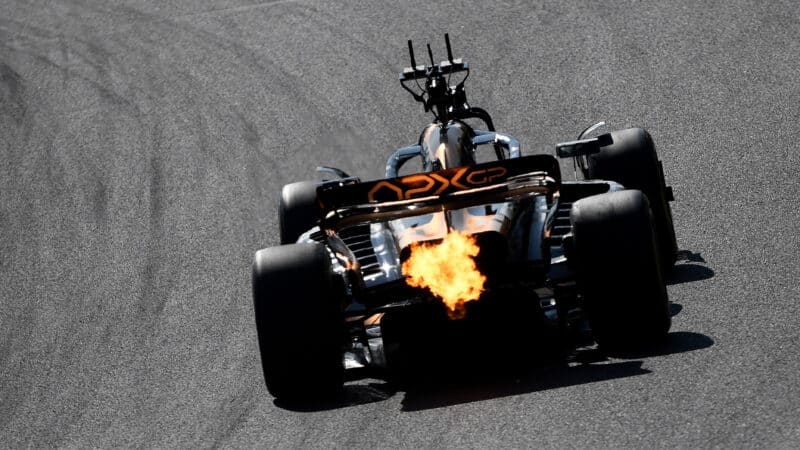
An Apex GP car hits the track in Hungary, with innovative camera rig attached
Getty Images
The cars have been driven predominantly by stunt drivers, who were likely put behind the wheel for many of the crash scenes shown in the trailer.
But Brad Pitt and Damson Idris have also spent a large amount of time in the cockpit, filming scenes on-track at Silverstone and Las Vegas in 2024.
Both actors trained for three months in various cars before shooting began — beginning in Formula 3 cars before moving up to Formula 2. Seven-time world champion Lewis Hamilton — who is also a co-producer on F1 — has been on hand to give tips as well as provide helpful insights as to where certain scenes should be shot.
“Lewis has been an incredible partner,” said Kosinski. “He jumps on Zoom [meetings] with me between races to go through the script, line by line, turn by turn, you know, tyre compound by tyre compound, to make sure that we are getting all the details right. Beyond that, on a creative and story level, he also has input.”
The locations
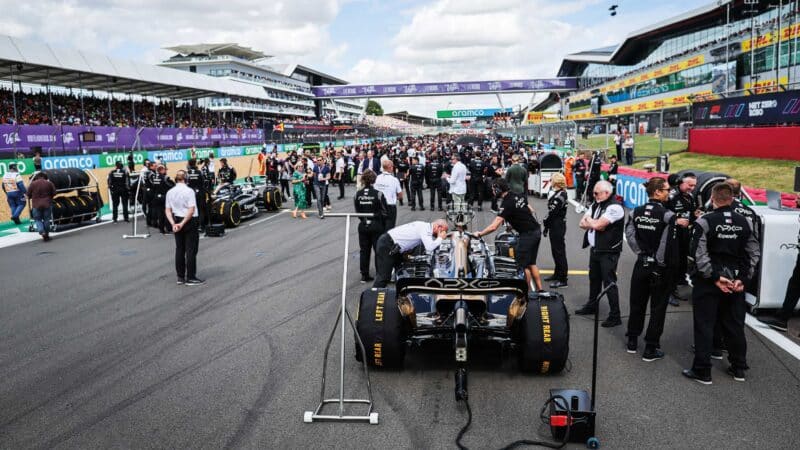
Apex GP on the back of the Silverstone grid. The team even had its own ‘prat perch’ on the pitwall for added reality
DPPI
F1 has had unprecedented access to a wide variety of tracks on the current world championship calendar — thanks predominantly to its close collaboration with F1 itself.
Across the 2023 and 2024 seasons, cars were shot on-track during real race weekends in Britain, Las Vegas, Mexico City, Zandvoort, Italy, Belgium, Japan and Hungary.
There were also additional shoots at the Daytona International Speedway, where Pitt was spotted filming scenes in the IMSA Daytona 500 behind the wheel of a Porsche 911 GT3 R — presumably establishing the back story for his character Sonny Hayes.
At some venues, it also appears that F1 has taken footage from real F1 on-boards. In F1’s second teaser trailer, an Apex GP car is shown approaching Eau Rouge at Spa with four cars racing ahead of it. Internet sleuths quickly tracked it down to footage from Pierre Gasly’s Alpine at the 2023 Belgian Grand Prix.
This technique could be used throughout the film to replicate some of the world championship’s most dramatic moments in recent years, and could help maintain a sense of authenticity for the die-hard race fans who will likely be watching.
